As you may be aware i have been having some fun with Red wheat here in Australia of late and have been keen to know the gluten strength of the flour. i was sent info on a test by Lance (Albacore) from Lancashire and its referred to as a hand washing test. The test info is in https://bakerpedia.com/processes/gluten-washing-tests/ i took 50 grams of the milled Red Wheat flour andthe test calls for 25g of water to make a dough, but l found at that rate i wasnt able to form a good dough so i added about 10g more so that i could make a well developed dough ball. The resulting dough ball is then placed under water from 20 to 60minutes i opted for 30, its then just a matter of washing the starch and in this case the bran and germ particles away from the dough ball. i did this in a large bowl and sieved the water from the bran flakes and small bits of gluten. I collected as much of the gluten shreds that i could see and continued rolling the gluten ball around in the palms of my hand where the flakes of bran could be felt coming away. at the end when i was satisfied that i had removed as much as was possible i weighed the Wet Gluten and recorded 10.2 g this equates to 20.4 for Wet gluten value. in the test The Cereals and Grains Association (AACC International) has a value of 30 - 45 as the highest and good bread making functionality. There is also a dry gluten value also so i dried the gluten out in the oven and recorded 5.34g from the 50g of flour used which would equate to 10.68% gluten. Another very learned friend said that she felt that the very best test is the resulting bread, and we have already seen that it has made a very good loaf. it might be interesting to repeat this exercise but sieve off the bran and germ in the dry stage and use 50 grams of the resulting flour! 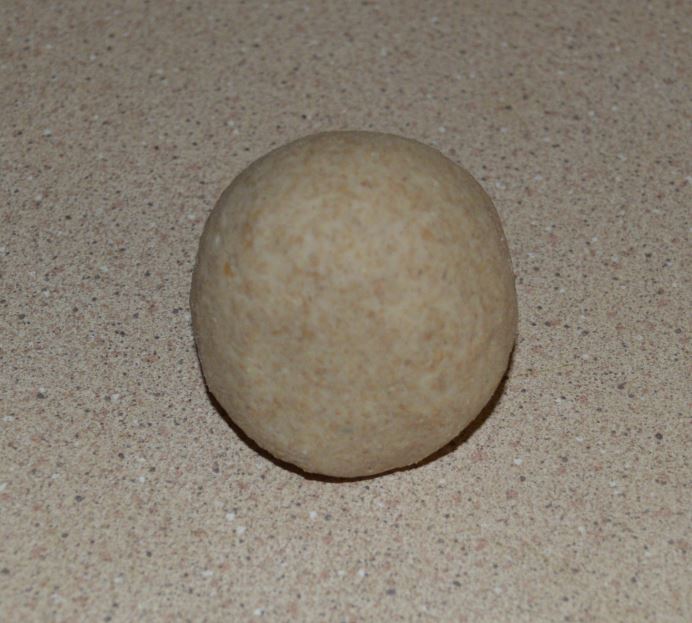 dough ball formed almost matches the bench top
dough ball formed almost matches the bench top 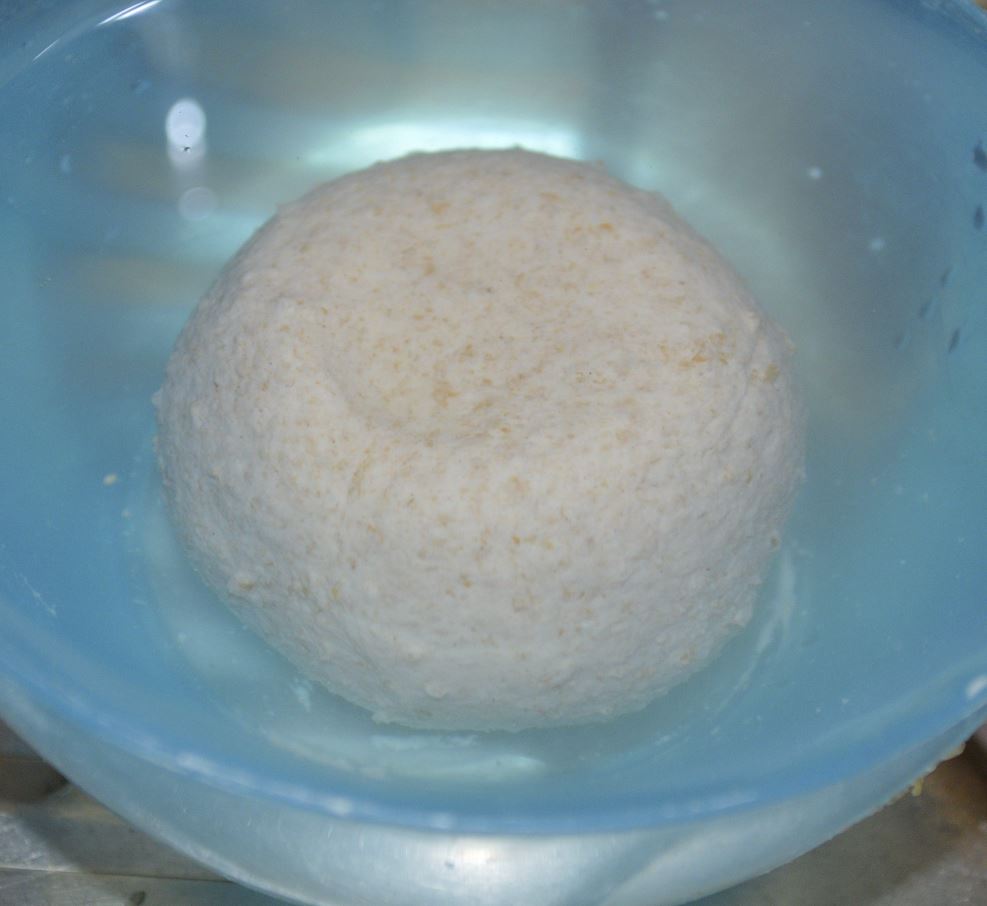 dough ball submerged for 30 minutes
dough ball submerged for 30 minutes 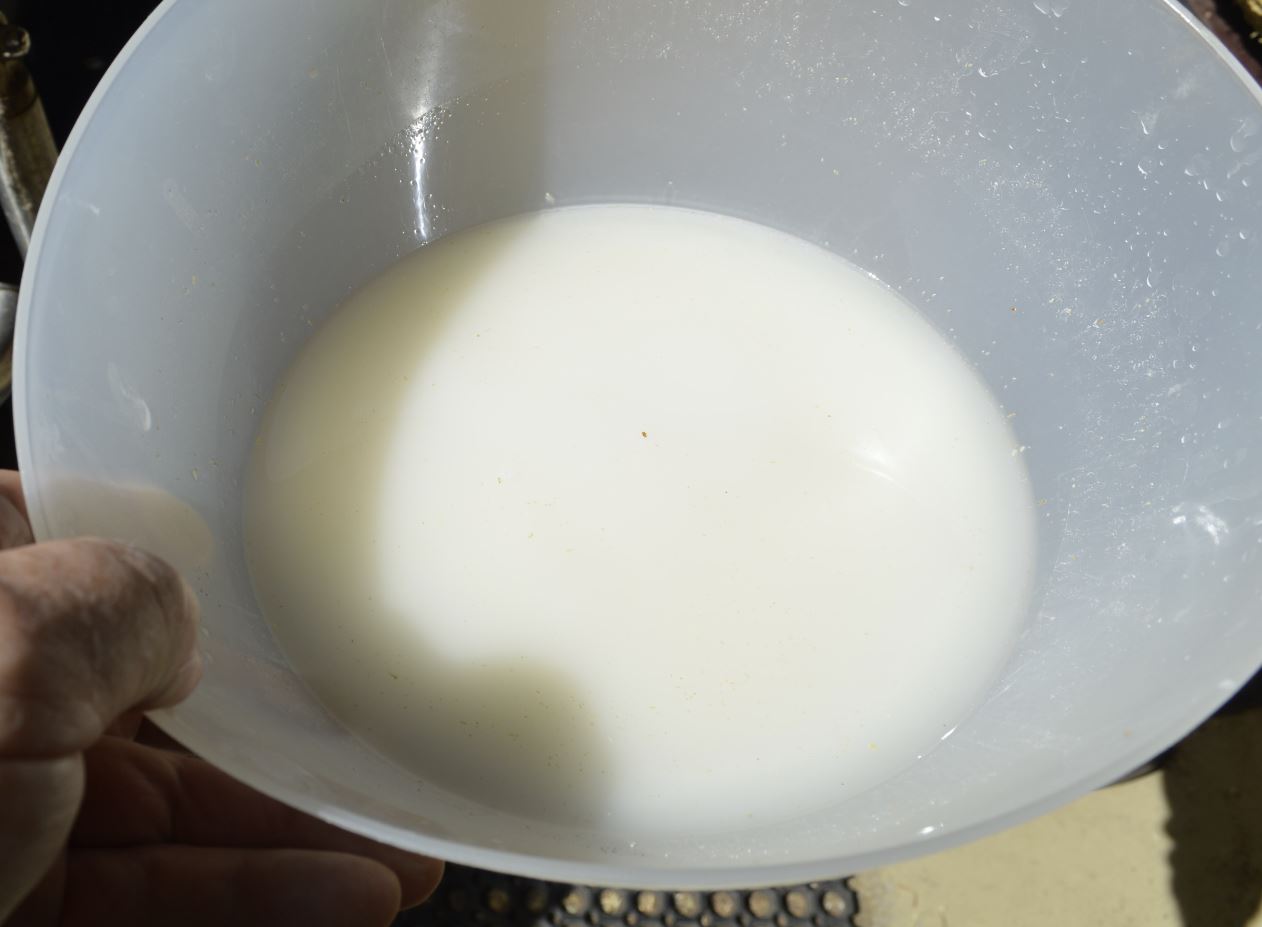 washing out starch in a bowl
washing out starch in a bowl 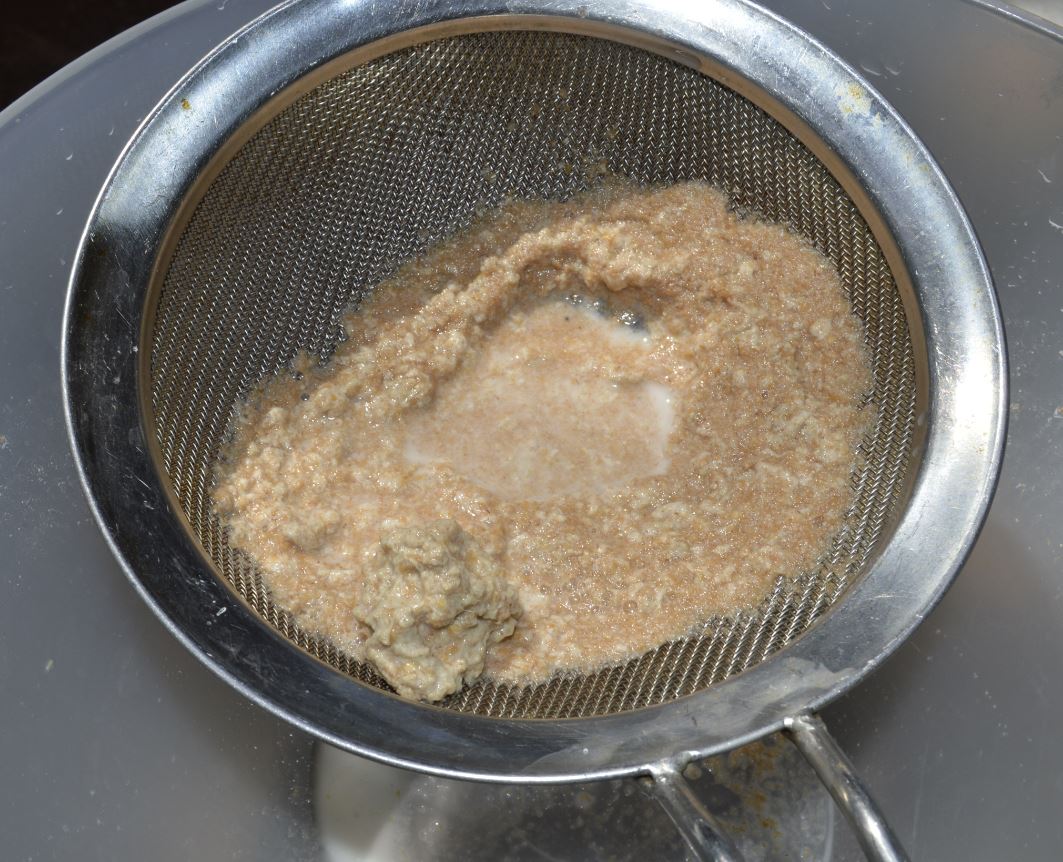 sieving out and collecting bran germ and gluten strands,
sieving out and collecting bran germ and gluten strands, 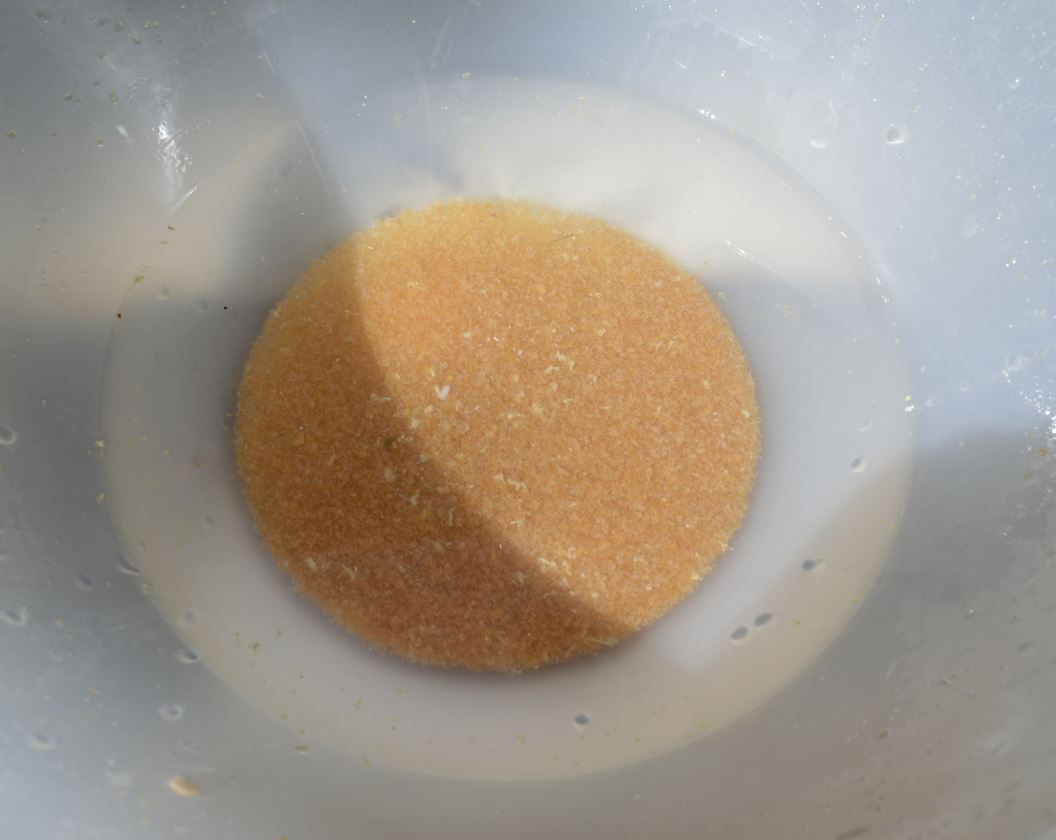 The bran with is Vibrant colour and some small shards of gluten
The bran with is Vibrant colour and some small shards of gluten  The final gluten ball that resulted from the 50gram 100% home milled flour sample of Australian grown Red Wheat.
The final gluten ball that resulted from the 50gram 100% home milled flour sample of Australian grown Red Wheat.
- yozzause's Blog
- Log in or register to post comments
Nice to see a seasoned baker such as you do this test Derek. When I posted about doing this test there were certain folks here than kinda poo pooed it. I certainly see the benefit in doing it when dealing with new flours you’ve never used before. As long as we do the test consistently we can compare the flours we use and have a better idea of how they might perform before committing to baking with it. As you said, in the end the best test is baking with it, but looking for a yardstick can be helpful as well.
Benny
When i first started my apprenticeship they said that the simple test was handy to have in your kit bag as the small millers that were about then were not able to blend and achieve the consistant results that the big mills are doing today . Mind you i guess we are going full circle here too with small artisan millers re emerging but i guess there is quite a bit more science now to assist.
i do remember when i first started the doughmakers duties i stumbled upon the technical info that the flour mill used to send out to the bakery, it was treated like junk mail and virtually bined as it came in, but i found it quite useful as it had all the data on the flour milling and the changes as the season progressed with recommendations on absorption rates and dough extensibility.
i guess in this case we could see that the flour was making good bread but there was no data on the flour as it wasn't classified under the Australian wheat standards other than feed wheat which doesn't have a minimum protein standard.
i am pleased to have received some correspondence from a technical officer who is going to chase up more information as the RGT Accroc is a French developed wheat of good quality used for milling in France.
regards Derek
Interesting. Thanks for sharing this.
I've been reading a very interesting book by Jennifer Lapidus, "Southern Ground", all about stone-milled flour. She also relates her own story that is very interesting.
She describes the way she assesses new wheat arriving at the mill. In assessing bread wheat, she chews on a handful of wheat to assess gluten strength. She’s looking for elasticity and extensibility. She wants the grain to transform into the consistency of chewing gum.
Not accurate, but a good indicator proper bread wheat.
Cheers,
Gavin.
yes that's what Lachie did when Tim first showed us the wheat!
Well done Derek for doing the test so precisely and in a good scientific manner. I've done it once and found it a little tedious! Balazlo on Instagram, who Benny knows well, is quite a champion of the test (open image in new tab to get a clearer view):
If the wet gluten level is low, I think he either blends or adds VWG to get the WG content up to better levels for baking.
Lance
Thanks Lance, Balazio's figure is a better flour water ratio for the initial dough, but im thinking that the amount of water isn't that important, you just need to be able develop a good dough the 50 gram Flour weight is good as there is less dough to wash out and less waste although the gluten produced can be added to your next dough, It keeps well as wet gluten in a saline solution Probably 2% salt would be good as that's what we usually add in our doughs , but thats calculated on the flour weight in Bakers percentage were as the real rate compared to the water value would be 2.87 if the water was 70% in a mix so between 2 -3% saline solution would be ideal solution to keep it in the fridge . The bakery that i did my apprenticeship in used to get Wet Gluten in 20 Litre buckets in a saline solution and was kept in the fridge it was added to wholemeal doughs. i look forward to repeating this test soon.
Derek
A good idea to save and store the wet gluten, Derek.
I've got some Italian Molino Tirelli tipo 1 flour that never seems to make a strong dough even when mixed with a good proportion of Caputo Manitoba Oro, so when I get a chance I'll try the wet gluten test on it and report back here.
Lance
i must say that i am quite a fan of Italian flours and have mad some nice breads with several different ones which i tend to buy if they are on the discount shelf getting close to their best before code. i must say that when covid first hit and the supermarket shelves were striped bare of flour as well as a host of other stuff Some stores in their rush to aquire replenishment had brands that they never stocked previously as their suppliers obviously said but we have some of this at the back of the warehouse! so it was a great opportunity to try something different.
i dont think i have seen the Molino Tirelli for sale here.
As promised, I did the wet gluten test with my Tirelli Tipo 1 flour.
I was thinking it wasn't very strong, but the wet gluten test suggests otherwise - I used a 50g flour sample and 35g water, as suggested by Derek, and recorded a WG content of 34% - pretty good, I think.
Here's the gluten ball:
And so as not to waste the gluten, I've just got it marinating in a little soy sauce, mirin and chinkiang vinegar. I'll fry it up later and see what it tastes like!
Lance
Great that you did the WGC test Lance, looks like your flour is medium by Laszlo's scale. When I did my testing I used double the weights of water and flour, your weights are less wasteful especially since you are going to cook your gluten. I'll be curious how it tastes. My stoneground WW flour yielded a WGC of 35 so also medium.
Benny
Well, it was pretty chewy, as you might expect. Not much taste of its own, but the marinade imparted some pleasant flavours.
I don't know if you've ever had those tins of mock duck, chicken or abalone, but it was a bit like that only tougher and not as tasty. Not surprising, because i think they are based on gluten or seitan.
Lance
I love that Chinese mock meat when done right with the right flavours and right textures.
you might to look at this then
https://yupitsvegan.com/basic-homemade-seitan/
Thank you Derek, I never thought to even consider making my own seitan. I’ll have a look at that recipe for sure.
Benny
Thanks for the link Derek. I had found a recipe on youtube but I prefer following text and pictures rather than video so I'll try yours.
Lance
Today i did a further test this time i weighed off 100g of flour and was able to sieve out 11g bran and germ and ended up with 85g of flour loosing 4 g to the air and containers so i guess that makes 85% extraction. The sieve wasn't particularly fine but did take some time to pass through,and fine flecks of bran/germ were visible. i then made a dough with 50g of the flour and 40g oaf water allowed it to sit under water for 40 minutes and then proceeded to wash out the starch into a captive bucket of water this was so i retained any small detached pieces of the gluten. i still managed to have some bran in the waste water and when id finished i ended up with 12g of wet gluten which equates to 24% wet gluten and according to the scale that Lance provided is below medium. The final assessment is of course in its baking performance!
One thing I wonder about with these wet gluten tests: does the result of the test depend on how well you initially mix and develop the gluten?
I'm just wondering if some of the protein gets washed away if it isn't developed into gluten.
Lance
Hi Lance we are told that gluten forms upon the wetting of flour with the proteins glutenin and gliadin combining and as we see with no mix doughs the gluten forms well enough to hold gas. We also see that gluten is developed to even better gas holding properties by either mechanical or physical manipulation.So i think good dough development is essential for the combining of all the gluten in a sample. If you strain the washed out starch you are able to see small threads of gluten especially if the dough hasn't had a good mix, its still possible to pick these up and incorporate into the main blob. as against washing it out under running water.
I checked three more flours today - all white bread flours. This time I used 50g flour + 30g water. Kneaded for a few minutes into a ball and then stored underwater for 1 hour before washing.
It's interesting that the Granoro Manitoba flour isn't particularly strong - I'd always thought that Italian Manitoba flours were meant to be strong. Eg Caputo Manitoba Oro, 14.3% protein, W 360-380.
Lance
Nicely done Lance, you’re more patient than I am, I did this once and that was enough LOL.
Benny
Well Benny, I guess your flours are a lot closer to Manitoba than mine, so It's not something you need to worry about too much!
I just wish all flours were W tested and marked with the index number.....
Lance